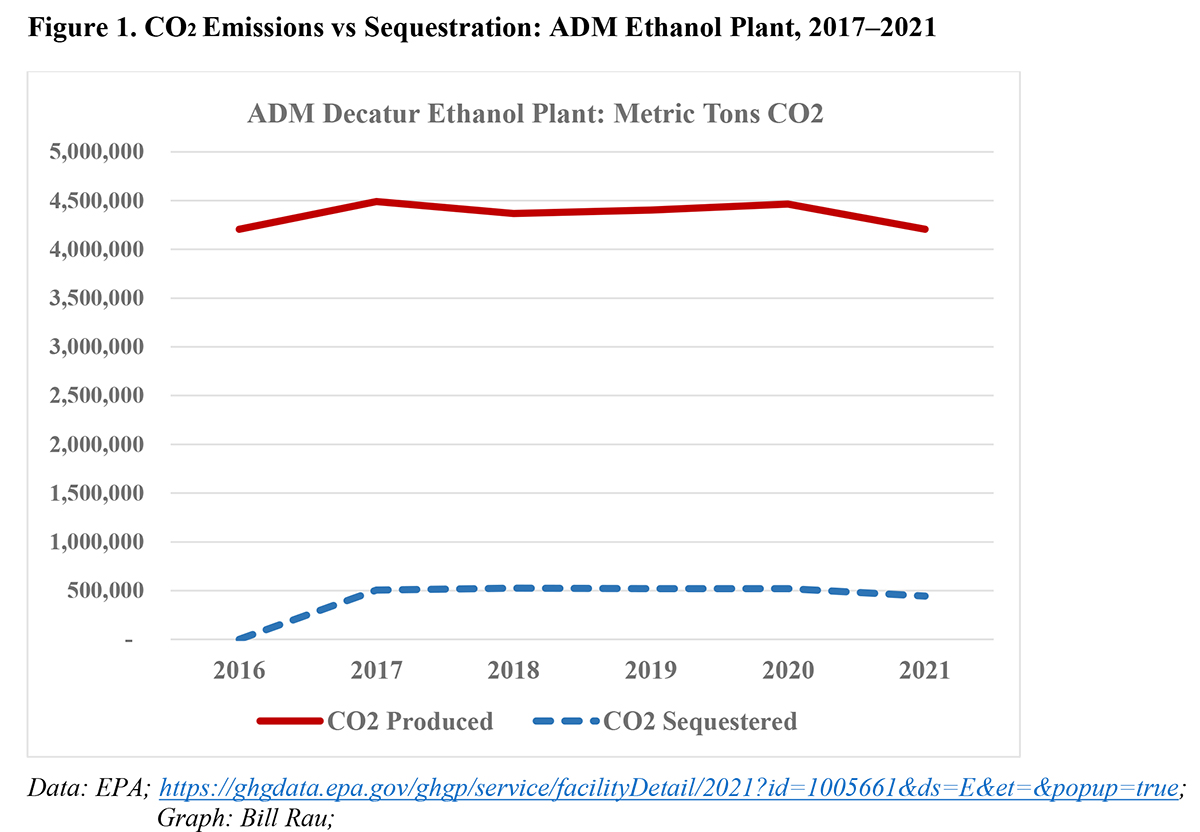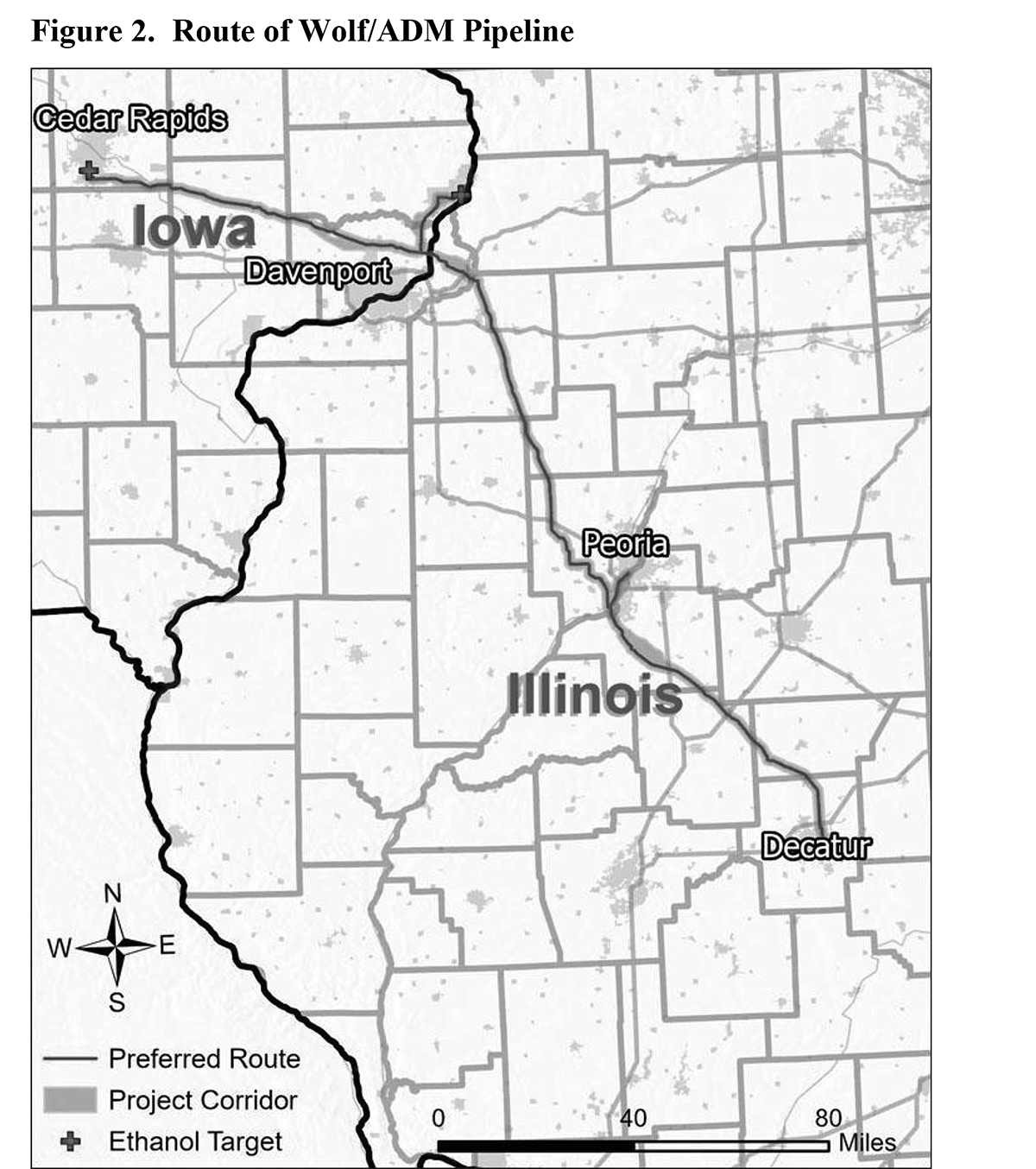Wolf/ADM (2022) wants to run a CO2 pipeline through Peoria and Tazewell Counties, route a trunk line to Peoria’s BioUrja ethanol plant, and possibly inject CO2 into the Mt. Simon Basin extending beneath your counties. For an antidote to Wolf/ADM PR, consider the following.
First, sequestered CO2 is a minuscule fraction of total CO2 produced at ADM’s Decatur plant (Hettinger 2020). This plant emitted 4.39 million metric tons of CO2 per year 2017-2021. In contrast, it only captured 503,000 tons of CO2 annually: i.e., 11.4% of the total carbon emissions from Decatur ethanol production (Figure 1). According to ADM’s engineering consultant, capturing and sequestering ethanol CO2 stack emissions “is likely 10 years out” due to sequestration energy demands and problems separating and processing CO2 stack gas (WSP 2020). In sum, current ethanol carbon capture technology earns a letter grade of “F-”.
Second, CO2 pipelines are dangerous. CO2 is transported as a liquid under great pressure. Even small amounts of water or impurities in the CO2 can embrittle pipes and cause catastrophic ruptures that rapidly disseminate large, dense CO2 blankets mostly devoid of oxygen. People under the blanket immediately gasp for air (CO2 is an asphyxiant) and will slip into unconsciousness if not quickly evacuated. Rescue is difficult, however, because the engines of first responder vehicles also need oxygen and sputter to a stop. This is exactly what happened after a CO2 pipeline rupture in Satartia, Mississippi; 46 people were hospitalized and another 200 evacuated (Zegart 2021).
Even so, Wolf/ADM plans to run a pipeline trunk to the BioUrja ethanol plant in Peoria (Figure 2). For an object lesion on an 8-inch pipeline rupture, view this video and imagine its impact on BioUrja’s vicinity:
https://brandcentral.dnvgl.com/mars/embed?o=4D2E198D781A6E6F&c=10651&a=N. A rupture in the BioUrja pipeline could cripple or kill residents of Peoria’s riverside public housing and shoppers in East Peoria.
Third, a major risk of CO2 sequestration is leakage of CO2 through its reservoir seal into groundwater aquifers above. CO2 acidifies water which dissolves minerals in sand and rock, including barium and uranium (Cooney 2010). Unmapped fracture networks in the caprock seal of the CO2 reservoir would allow toxic minerals to infiltrate upward into Mahomet Aquifer drinking water. Additionally, fast injection of CO2 increases the risk of leakage from CO2 reservoirs, and the $50 per metric ton subsidy for sequestered CO2 incentivizes Wolf/ADM to inject CO2 swiftly.
Fourth, when pipelines are backfilled, topsoil and subsoil can be intermixed and/or compacted by heavy equipment. The end result? Long-term loss of crop yields along the pipeline corridor. Ask Mike Kelley, Chair of the McLean County Soil Conservation Board. Corn yields dropped from 200 to 170 bushels per acre for 18 acres of his farm that were transected by Enbridge’s oil pipeline (Bennett 2017). Other farmers have experienced worse damage to soil and crop yields.
So, cui bono? Who benefits? Do residents benefit if Peoria and Tazewell Counties become thoroughfares and garbage dumps for toxic waste? Do our farmers or businesses benefit? Or does Wolf/ADM benefit from large subsidies funded with our taxes? Also, will fossil fuel companies — ardent carbon sequestration promoters — benefit from greenwashing failed carbon capture schemes which allow them to profit by polluting?
Note
1 An earlier version of this analysis was presented to the McLean County Land Use and Development Committee on February 7, 2023. Another CO2 pipeline (Navigator Heartland Greenway LLC) wants to ship CO2 through McLean County and possibly bury it in the county as well.
References
Bennett, Chris. 2017 (Nov 4). Pipelines and Farmers Battle Over Lifetime Loss. Farm Journal; https://www.agweb.com/news/crops/crop-production/pipelines-and-farmers-battle-over-lifetime-loss
Cooney, Catherine M. 2010 (Dec 7). Study Charts How Underground CO2 Can Leach Metals into Water. Inside Climate News; https://insideclimatenews.org/news/07122010/study-charts-how-underground-co2-can-leach-metals-water/
Hettinger, Johnathan. 2020 (Nov 19). Despite hundreds of millions in tax dollars, ADM’s carbon capture program still hasn’t met promised goals. Midwest Center for Investigative Reporting; https://investigatemidwest.org/2020/11/19/despite-hundreds-of-millions-in-tax-dollars-adms-carbon-capture-program-still-hasnt-met-promised-goals/
Wolf/ADM. 2022 (Apr). Midwest Carbon Capture and Storage (CCS) Project Overview; https://noillinoisco2pipelines.org/wp-content/uploads/2022/05/WolfCarbonOnePager18354-2.pdf
WSP. 2020 (Mar). ADM Carbon Reduction Feasibility Study. WSP; https://assets.adm.com/Sustainability/2019-Reports/ADM-WSP-Feasibility-Study-and-Goal-Document.pdf
Zegart, Dan. 2021 (Aug 260. The Gassing Of Satartia. Huff Post; https://www.huffpost.com/entry/gassing-satartia-mississippi-co2-pipeline_n_60ddea9fe4b0ddef8b0ddc8f




3 comments for “Heat waves in Red & Black: CO2 pipeline for Peoria? Who Benefits?”